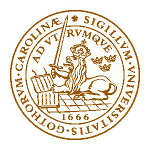 Department of Theoretical Physics
Department of Theoretical Physics
FYTB03 (part of FYTA12) VT 2016
Analytical Mechanics and Special Relativity
Note: Reexam August 22nd
10.15-15.15 in the Cassiopeia lecture room in the Astronomy building
Note that this is the last standard exam for this course!
Schedule
Lectures marked with K, exercise sessions marked with ÖK, SI sessions marked with SIK, the lab marked with LK1 (mandatory) and the exam marked TK1 in the preliminary course schedule. Note thus that the course FYTB03 only covers the first studying period.
Literature
Analytical Mechanics part: John R. Taylor, Classical Mechanics (ISBN 978-1-891389-22-1), University Science Books, 2005
Special relativity part: W. Rindler, Introduction to Special Relativity (ISBN: 978-0521887052), Oxford Science Publications, 1991
Swedish alternative for both parts: Hans-Uno Bengtsson, Om klassisk fysik (ISBN 91-40-62020-4), Gleerups, 1995 (For sale at the theoretical physics expedition.)
Special relativity part, aside reading: V. Faraoni Special Relativity. Within LU this book can be downloaded for free here.
Preliminary course plan, VT 2016
Mechanics:
- v. 3
-
Fermat's principle, basic calculus of variations, brachistochrone problem, Euler-Lagrange's equations, principle of least action, generalized coordinates.
(Taylor p. 215-230, 237-256, example 6.3 and 7.2 not covered in lectures) - v. 4
-
Conservation of total momentum,
cyclic (ignorable) coordinates,
Noether's theorem,
generalized coordinates, velocities, momenta and forces,
conservation of energy,
Lagrange multipliers with a condition on the integral,
the hanging chain,
Lagrange multipliers and constraint forces (constraints on the integrand),
the vibrating string using two underlying integration variables,
the vibrating string using an infinite number of generalized coordinates.
(Taylor p. 241-242, 267-272, 275-280, the vibrating string not in Taylor) - v. 5
-
The two body problem and Kepler's laws,
the double pendulum,
Lagrange's equations for electromagnetism and gauge invariance (advanced topic).
(Taylor p. 293-315, 417, 430-436, 272-275) - v. 6
-
The Hamilton formalism,
gravitational bending,
Rutherford's scattering formula, Poisson brackets (advanced topic, not in Taylor).
(Taylor p. 521-536, 572-576)
Special relativity:
- v. 7
-
The Michelson–Morley experiment (length contraction),
a laser clock (time dilation),
derivation of the Lorentz transformation,
consequences of the Lorentz transformation,
spacetime (Minkowski) diagrams,
the twin paradox, the length contraction paradox.
(Rindler p. 1-32, 40-41, 52-55, alternative for length contraction paradox: Taylor p. 613-615) - v. 8
-
Scalars, four-vectors and tensors,
proper time,
four-velocity, four-acceleration, four-momentum,
invariant mass,
centre of momentum frame,
four momentum for photons,
examples of four-momentum kinematics, particle collisions,
threshold energy.
(Rindler: Appendix A: A1-A6, A11, Ch 4: p. 49-60, Ch 5: 69-86
Comments to text:
- As is almost always done in physics, we define tensors as in A5.
- What Rindler calls valance of a tensor we, and almost all of the rest of the world, call rank.
- What Rindler calls qualified tensor we, and most of the physics world, just call tensor.
- v. 9
-
Forces in special relativity,
relativistic structure of Maxwell's theory,
the electromagnetic field tensor,
Lorentz-boosts in general directions,
gauge invariance,
invariance of metric,
boosts and rotations, various examples.
(Monday Lecture: Rindler: p 90-92, 102-108. Wednesday lecture: Bengtsson: 146-153, copies of these pages will be handed out during the lecture. An English alternative is given by sections 2-7 in these notes. ) - v. 11
-
The free relativistic Lagrangian,
various examples.
(Rindler p. 93-96, only the free Lagrangian.) - v. 12
-
Repetition and exam in mechanics and special relativity.
Lecture notes
Lecture notes for some of the lectures will be made available here.Mechanics:
- Lecture 1
- Lecture 2
- Lecture 3
- Lecture 4
- Lecture 5
- Lecture 6
- Lecture 7
- Lecture 8
- Three body problem
- Repetition
Special relativity:
Exercises
Exercises from problem solving sessions:- Exercise sheet 1, January 22nd, 2016.
- Exercise 5 is to hand in
- Exercise sheet 2, February 5th, 2016.
- Exercise 6 is to hand in
- Exercise sheet 3, February 19th,2016.
- Exercise 8 is to hand in
- Exercise sheet 4, March 4th, 2016.
- Exercise sheet 5, March 18th, 2016.
Additional exercises:
- Problem sheet with exercises for the mechanics part (Swedish)
- Problem sheet with exercises for the mechanics part (English)
- Problem sheet with exercises for relativity (Swedish)
- Problem sheet with exercises for relativity (English)
- Some exercises from the book "Om klassisk fysik" (English translation)
- Ch 7: 7.1, 7.2, 7.14, 7.15, 7.16, 7.17, 7.18, 7.20, 7.21, 7.22, 7.24, 7.26, 7.27, 7.29, 7.30 (this chapter is especially important).
- Ch 8: 8.4.
- Ch 11: 11.2, 11.19.
- Ch 13: 13.1, 13.2, 13.3, 13.5, 13.6, 13.8, 13.9, 13.11, 13.13, 13.19, 13.21.
- Ch 1: 1:1, 1:4, 1:5, 1:8, 1:9, 1:10, 1:11.
Hand-in exercises spring 2016
The solutions should (if nothing else is stated) be handed in within six days, i.e, at the latest the Thursday the week after at the exercise session at 1:15 pm. The solutions should be typeset using a computer or written in a nice and easily readable manner. The exercises should be solved individually and left in the mailbox of Harsh Shah, (same corridor as HUB, opposite side of the stairs).
Bonus rules: Swedish / EnglishOld exams
These old exams are here for exercise, be aware however, that the course has changed. In particular, we do not treat Binet's equation but we do treat Hamiltonian mechanics.April 2010 (with suggestions for solutions), June 2010, August 2010, April 2011, June 2011, March 2014(eng), March 2015(eng) (with scanned suggestions for solutions), March 2016(eng) .